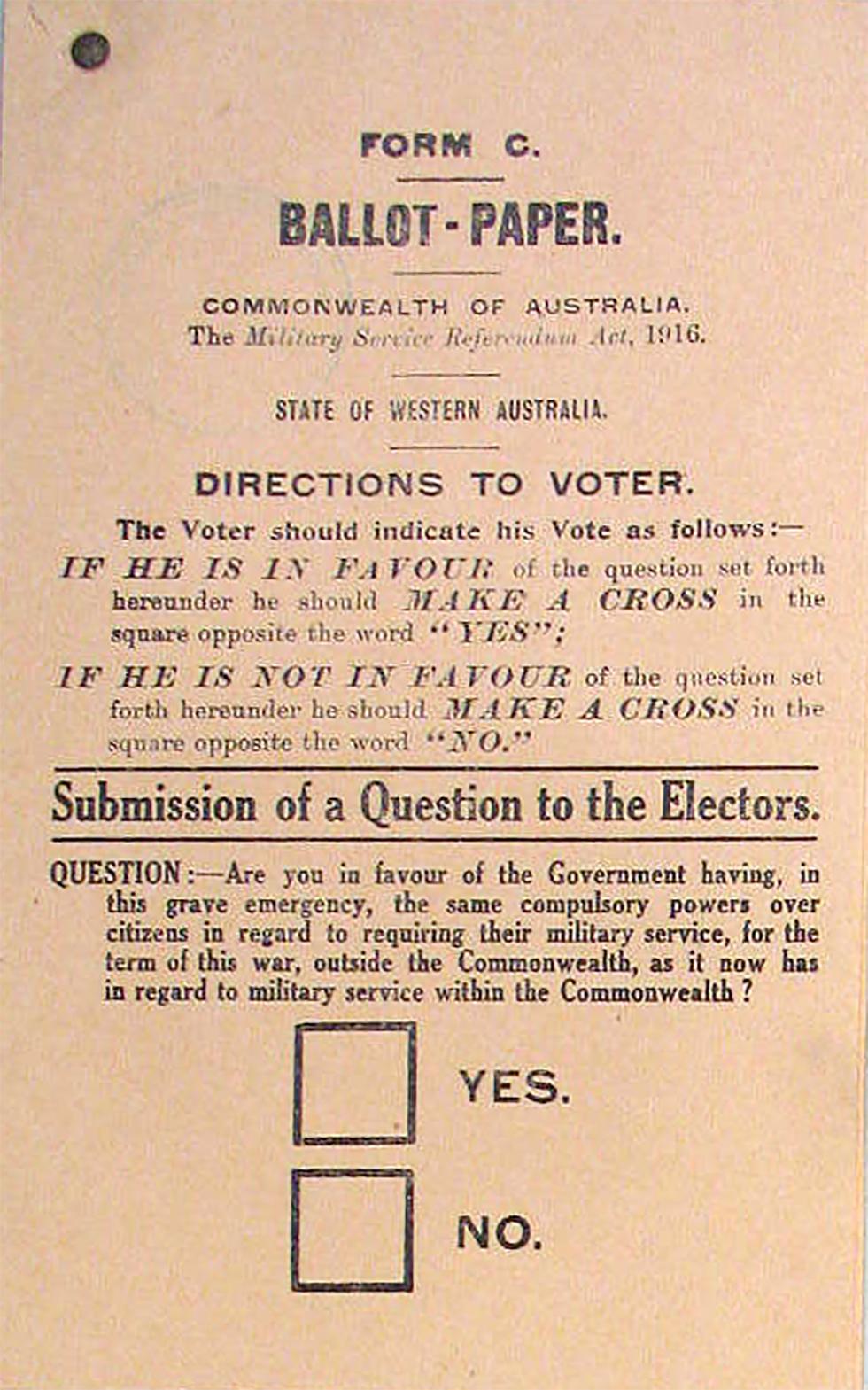


Transcript
FORM C.
BALLOT – PAPER.
COMMONWEALTH OF AUSTRALIA.
The Military Service Referendum Act [italicised], 1916.
STATE OF WESTERN AUSTRALIA.
[Subheading:] DIRECTIONS TO VOTER.
The Voter should indicate his Vote as follows:-
IF HE IS IN FAVOUR of the question set forth hereunder he should MAKE A CROSS in the square opposite the word "YES";
IF HE IS NOT IN FAVOUR of the question set forth hereunder he should MAKE A CROSS in the square opposite the word "NO."
[Heading:] Submission of a Question to the Electors.
QUESTION:- Are you in favour of the Government having, in this grave emergency, the same compulsory powers over citizens in regard to requiring their military service, for the term of this war, outside the Commonwealth, as it now has in regard to military service within the Commonwealth?
[Two large checkboxes labelled 'YES' and 'NO'.]
About this record
This is a ballot paper from a plebiscite, or advisory referendum, held on 28 October 1916, in which the Australian people voted on whether to introduce conscription for military service outside of Australia. This ballot paper is from the state of Western Australia. Under the Military Service Referendum Act 1916, wartime Labor Prime Minister William ‘Billy’ Hughes asked Australians to vote for or against the proposal.
Educational value
- Although often referred to as a ‘referendum’, the vote was actually a plebiscite. This is because the Australian Government already held the power to introduce conscription, so no change to the Constitution was required. Instead, a vote was held to gauge popular opinion about conscription in Australia. Plebiscites, unlike referendums, have no binding legal consequences.
- The First World War differed from earlier conflicts in the strategies and technologies involved, as well as in the scale of the conflict and the losses sustained. Going into the war, nobody knew it would last so long. By October 1916, when the plebiscite was held, numbers of volunteers for the Australian Imperial Force were depleted; support for the conflict was decreasing; and the end of the war was still not in sight.
- Beginning in 1915, the Australian Government tried to increase falling enlistments through mass recruitment drives and public campaigns. These were successful for a time, but their effectiveness waned throughout 1916. Prime Minister Hughes became convinced that there was no choice except to make military service compulsory. Britain had introduced conscription in January 1916 and New Zealand followed in June 1916.
- The conscription debate divided the Australian people. Supporters saw compulsory service as a sign of support for and loyalty to Britain and to the many thousands of men already fighting or killed in the war. Opponents questioned the effectiveness—and the morality—of forcing men to fight and, in some cases, they also questioned the war itself. Large marches, strikes and propaganda campaigns were organised to protest the proposal.
- The Labor government was severely divided on the issue and split within weeks of the ballot. After leaving the party, Prime Minister Hughes and other pro-conscription supporters created the ‘National Labor Party’, in competition with the Labor Party.
- The results of the 1916 plebiscite were very close: 51.6 per cent of the population voted against conscription and 48.4 per cent for it. Although the ‘yes’ vote ultimately lost, it won the majority in three states as well as in the federal territories. A second plebiscite on the same issue was held in December 1917. It was lost by a larger, but still narrow, margin.
- The First World War (WW1) was the first time that conscription for overseas service was planned for Australia. In the decade before WW1, Australia had introduced compulsory military training for boys and young men, but this did not extend to service overseas. During World War II the government passed a bill obliging members of the Citizen Military Forces to serve in Australia and the South-West Pacific Zone. Between 1965 and 1972, Australian conscripts, known as National Servicemen, were required to serve in the Vietnam War.
Need help with your research?
Learn how to interpret primary sources, use our collection and more.

